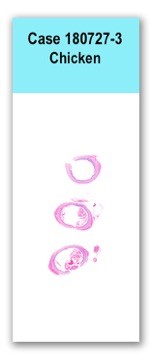Case 3 180727 (T1800632)
Conference Coordinator: Dr Elizabeth Rose.
//
41-day-old broiler chicken
A flock of 41-day old broiler chickens were presented with a history of increased mortality (up to 100 or more mortalities per day). On physical exam, the chickens had watery, closed eyes.
Chickens had swollen, edematous eyelids. The trachea contained mucous and some foam admixed with rare blood clots and fibrin.
Three transverse cross-sections of trachea are examined in which the tracheal lumina contain copious amounts of fibrin, extravasated red blood cells, heterophils, lymphocytes and syncytia. Syncytia and individual, sloughed epithelial cells frequently contain pale eosinophilic, intranuclear inclusion bodies that occasionally peripheralize the chromatin. The tracheal mucosa is multifocally necrotic to ulcerated. Remaining epithelium is attenuated and variably ciliated, often fusing to form syncytia. The subjacent submucosa is densely infiltrated by heterophils, lymphocytes and plasma cells. Vessels within the skeletal muscle and connective tissue adjacent to the trachea are often surrounded by cuffs of lymphocytes and plasma cells.
No special stains.
Trachea: Severe diffuse acute fibrinonecrotizing hemorrhagic tracheitis with intranuclear inclusion bodies and syncytia
The three most important respiratory diseases of chickens are infectious laryngotracheitis (ILT), infectious bronchitis and Newcastle disease. Infectious laryngotracheitis, also known as fowl diphtheria, is caused by infectious laryngotracheitis virus (Gallid herpesvirus type I) and may infect pheasants and peafowls as well as chickens. Affected birds are typically presented in acute respiratory distress with coughing and expectoration of bloody, mucoid exudate. Morbidity is high in all age groups (90 to 100%) and mortality is variable (10 to 70%) depending on the pathogenicity of the strain. Recovered birds may become carriers, as the virus becomes latent in the trigeminal nerve ganglion and reactivates in immunocompromised carriers. Outbreaks have occurred in broilers consequent to reversion to virulence of the live-attenuated vaccine virus strains.
Clinically, infected animals become severely dyspneic and weak, with decreased egg production, coughing, head shaking, weight loss and bloody discharge from the beak and nostrils. Death occurs consequent to suffocation or secondary bacterial or fungal infection. Gross lesions include laryngotracheitis with necrosis, hemorrhage, ulceration and pseudomembranes that may occlude the trachea. Intranuclear inclusion bodies can be found in the tracheal and conjunctival epithelial cells early in infection but are difficult to identify in chronic cases due to desquamation of the epithelium. Multinucleated syncytial cells may also be a prominent feature. Definitive diagnosis may be acquired through virus isolation, qPCR and IHC.1. Garcia, M, Spatz S, Guy JS. Infectious laryngotracheitis. In: Swayne DE, ed. Diseases of Poultry. 13th ed. Ames, IA: Wiley-Blackwell Publishing; 2013:161-179.
2. Hamer SA, Amuzie CJ, Williams KJ, Smedley RC. Pathology in practice: infectious laryngotracheitis in laying chickens. J Am Vet Med Assoc. 2013;242(4):477-9. Case contributor: Dr. Patti Pesavento
